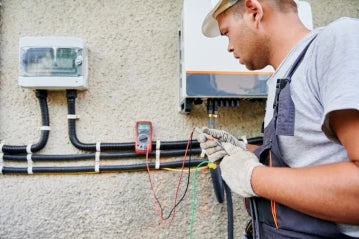
Harnessing solar energy has become increasingly popular as individuals and businesses strive to reduce their carbon footprint and lower electricity costs. Solar inverters play a vital role in this process by converting the direct current (DC) generated by solar panels into alternating current (AC) that can power our homes and businesses. Among the innovative technologies incorporated into modern solar inverters, MPPT (Maximum Power Point Tracking) stands out as a game-changer. In this blog post, we will delve into the inner workings of MPPT solar inverters and explore the benefits they offer to customers who are considering solar energy solutions.
What Does MPPT Mean on Inverter?
Before we dive into the intricacies of MPPT solar inverters, let's first understand what MPPT actually means. MPPT stands for Maximum Power Point Tracking. It refers to the intelligent algorithm embedded in a solar inverter that continuously tracks and adjusts the operating point of the solar panels to maximize power generation. By constantly optimizing the power output of the panels, MPPT ensures that solar inverters extract the most energy from the sunlight falling on the panels.
How Does MPPT Work in an Inverter?
Now that we grasp the concept of MPPT, let's take a closer look at how it works within a solar inverter. The key to MPPT lies in its ability to identify the maximum power point (MPP) of the solar panels, which is the voltage and current combination that yields the highest power output. To achieve this, the MPPT algorithm employs a sophisticated process of monitoring, analyzing, and adjusting the operating conditions.
Imagine a scenario where clouds temporarily obscure the sunlight falling on your solar panels. In such cases, the MPPT inverter detects the sudden drop in power output and promptly adjusts the operating point of the panels to maintain the optimal voltage and current levels. Similarly, if the intensity of sunlight increases, MPPT rapidly adapts to ensure that the panels operate at their peak efficiency. By continuously monitoring and adapting to changes in environmental conditions, MPPT maximizes the amount of energy harvested from the sun.
What is an MPPT Inverter?
Now that we have a basic understanding of how MPPT works, let's explore what an MPPT inverter actually is. An MPPT inverter is a type of solar inverter specifically designed to integrate MPPT technology. It features advanced circuitry and software that enables precise tracking of the MPP of the solar panels. Compared to traditional inverters, MPPT inverters offer superior energy conversion efficiency and optimize power generation under varying weather conditions.
The Function of MPPT in Solar Inverters
The primary function of MPPT in solar inverters is to maximize the power output of the solar panels and ensure efficient energy conversion. It achieves this by dynamically adjusting the voltage and current levels of the panels to match the load requirements and environmental conditions. By extracting the maximum available power from the panels, MPPT significantly improves the overall performance of the solar energy system.
One of the key advantages of MPPT is its ability to mitigate power losses. Traditional inverters operate at a fixed voltage and current, which can lead to significant power losses when the operating conditions deviate from the ideal parameters. MPPT, on the other hand, adjusts the operating point to always operate at the MPP, thereby minimizing power losses and optimizing the energy harvest.
Benefits of an MPPT Solar Inverter
Investing in an MPPT solar inverter brings a multitude of benefits for customers considering solar energy solutions:
1. Improved energy conversion efficiency: MPPT technology ensures that the solar panels operate at their highest efficiency, resulting in greater energy output from the same amount of sunlight.
2. Enhanced performance under varying weather conditions: MPPT constantly adapts to changing sunlight intensity, allowing for optimal power generation even in cloudy or partially shaded conditions.
3. Compatibility with a wide range of solar panel configurations: MPPT inverters are designed to accommodate various solar panel configurations, enabling customers to choose the panels that best suit their needs without compromising efficiency.
4. Longer lifespan of the solar panels and overall system: By preventing power losses and operating the panels at their optimal points, MPPT minimizes stress on the panels, extending their lifespan and maximizing the return on investment.
5. Cost-effectiveness and return on investment considerations: The increased energy output and improved efficiency of MPPT inverters result in faster payback periods and higher financial returns for solar energy system owners.
Conclusion
MPPT solar inverters represent a significant advancement in the realm of solar energy solutions. By intelligently tracking and optimizing the power output of solar panels, MPPT technology ensures that customers can maximize the energy harvest from the sun. The improved efficiency, enhanced performance under varying weather conditions, and compatibility with different panel configurations make MPPT inverters a compelling choice for customers seeking to invest in solar energy. Embrace the power of MPPT technology and unlock the full potential of your solar energy system.
At Ecgsolax, we make some of the best MPPT solar inverters on the market. With Ecgsolax all in one MPPT inverters, you can confidently embrace a sustainable lifestyle while enjoying the benefits of reduced energy costs and a smaller carbon footprint.

0 Kommentare